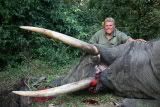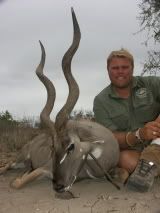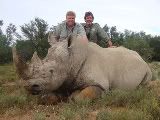

 The Accurate Reloading Forums
The Accurate Reloading Forums  THE ACCURATE RELOADING.COM FORUMS
THE ACCURATE RELOADING.COM FORUMS  Hunting
Hunting  African Big Game Hunting
African Big Game Hunting  Namibia in April?
Namibia in April?Go  | New  | Find  | Notify  | Tools  | Reply  |  |
| one of us |
I'm looking at a free range Kudu and Gemsbok hunt in Namibia. Is the beginning of April to early in the year to hunt there? Frank "I don't know what there is about buffalo that frightens me so.....He looks like he hates you personally. He looks like you owe him money." - Robert Ruark, Horn of the Hunter, 1953 NRA Life, SAF Life, CRPA Life, DRSS lite | ||
|
| One of Us |
Frank it can be too early depending. In April this year the rains washed out roads all over the Kunene and the rivers made crossing many areas impossible. We had road work staff stranded for four days in one area. Also, depending on where you hunt, the grasses and new growth are only just coming out so the animals are pretty scattered. If you are in an area without grasses, you might not see any game animals whatsoever. But that's why we call it open range hunting. Again, depending on where you want to hunt, late June into July is much more productive as water points dry up and animals begin to congregate. ___________________ Just Remember, We ALL Told You So. | |||
|
| one of us |
That was my concern with the early season, the possibility of heavy rains and the animals being scattered widely due to the new grass. I have a friend going with me on maybe his only trip to Africa and am worried about his experience. The flight deals are great at that time though. Frank "I don't know what there is about buffalo that frightens me so.....He looks like he hates you personally. He looks like you owe him money." - Robert Ruark, Horn of the Hunter, 1953 NRA Life, SAF Life, CRPA Life, DRSS lite | |||
|
| One of Us |
It's a toss up. Book an extra few hunting days in case, or wait a little and pay a little more in airfare. While this year was a pleasant anomaly with massive rains, you could luck out. Then again, you're counting on luck. There is always Etosha to see and roads are not too bad when it rains. ___________________ Just Remember, We ALL Told You So. | |||
|
| One of Us |
We went to Namibia in April 2012 and it was great. Some rain but not too bad. I’d go again at that time. If you have that much to fight for, then you should be fighting. The sentiment that modern day ordinary Canadians do not need firearms for protection is pleasant but unrealistic. To discourage responsible deserving Canadians from possessing firearms for lawful self-defence and other legitimate purposes is to risk sacrificing them at the altar of political correctness." - Alberta Provincial Court Judge Demetrick    | |||
|
| One of Us |
Frank, I don't know if this would be a consideration for you and your friend but some have told me animal capes are more prime in the cooler period, at least in the southern Africa region. I guess this means June & July mainly. I cannot verify from my own experiences. Taxidermists here would be qualified to make comment. If no capes are required a Kudu rug would be very desirable. I only have Kudu backskin but it's a very attractive hunting memento. Good luck with hunt planning. Hunting.... it's not everything, it's the only thing. | |||
|
One of Us |
We’ve been twice in early April and only experienced a bit of rain. We wouldn’t hesitate to go back at that time of year. Yes the animals were more scattered but we still had great hunting. | |||
|
| One of Us |
We go to Namibia a couple of times a year, either for fun for ourselves or taking clients. Earliest I've been there has been early April - latest end of September. Only hunt in one area in the NW'rn mountains S. of Etosha, between Kamanjob and Outjo. We've rented cars and have driven all over the country over the past 10-years. Airfare peak prices are between 15 May and 15 Aug. If you can start your trip before 15 May or after 15 Aug you can save anywhere from 20-30% over high season. Was there last year (2017) the first two weeks of Apr, the last two weeks of June and the last two weeks of Aug to end of first week of Sep. As Opus stated, Apr is usually the end or at least the later part of the rainy season. There are clients at my friends place right now and they have lost a couple of days due to rain. Temps are warm (mid-high 80's) and the humidity is 60-70%. If you go, make sure the place you stay has a/c in your sleeping quarters or at LEAST fans of some kind. Without, sleeping comfortably until early morning hours could be a challenge. Up side of being there in later Apr is you will get to see it green and flowering. As mentioned, the game will likely be widely scattered, unless you hunt a high fence place. If you're hunting the mountainous areas, the rains collect in the cracks and fissures and pool in small pockets that last for several weeks. Some game, like gemsbok, are not really that water dependent, but will drink everyday if it is available. There is really no need for game to come down out of the mountains as there is still grass high up or to drink at man-made water points in the valleys. Still a little early for any of the "rut" to be "on" for most species. Bachelor bull herds of gemsbok are starting to break up in anticipation of the rut. Kudu bulls who've maintained some very loose bachelor bull associations start to become even more reclusive and solitary. By the end of May, the temps are more comfortable and the rains are pretty much completely over, humidity is getting back down to the normal - under 5%. Mopane bees will start to taper off and only bother you during the heat of the day. Jun-Jul, temps will be at the lowest, nearly zero chance of rain but, have been there when a couple of freak fronts passed through. Can be cold enough to have frost on the vehicles in the morning and ice on some of the water points. By mid/late morning you're generally back in shirtsleeves. Have pictures of some zebra in snow that were taken in southern Namibia a few years ago. Winds can become a challenge for a few days at a time. Almost never have any or, very few, days with mopane bees driving you crazy. Aug is probably my favorite month. Temps are comfortable day and night. Game has been able to establish their "routines/routes" going between feeding areas and water points. Winds are usually mild to calm. There are still a few animals at the tail end of the rut - seems to always see a few kudu bulls still unusually careless on hot cows. Mopane bees will start getting more active during the heat of the day the later into Aug you get. September, mid-day temps are starting to get warm pretty quickly. Animals have become reliant on the the man-made water points. Rut is pretty much over for all species. If you are going to be night hunting for certain species, Aug and Sep evening/night temps will be pretty comfortable. Latest I've been there has been the end of Sept and by that time the highs were to the point I was ready to go. Depending on what part of Namibia you're thinking about going to, temps will change a bit between north and south. Namibia is about the size of the state of Texas and the cold ocean currents cutting up along the west coastal areas have a big influence several hundred kilometers inland. Also the Caprivi Strip/Kavango Region/Okavango River Delta is an entire environment onto itself. If you can give an idea of the area/region of Namibia you're looking at it will be a bit more helpful with specifics. | |||
|
| one of us |
Thanks all, I've hunted the Khomas Hockland Highlands in August of 2008 and was very comfortable then although it was windy every day. We're looking to do a tent camp in the Erongo Mountains with only solar electricity, no air-con or other luxuries so later in the year is going to have to do, I hate sweating through the night. Frank "I don't know what there is about buffalo that frightens me so.....He looks like he hates you personally. He looks like you owe him money." - Robert Ruark, Horn of the Hunter, 1953 NRA Life, SAF Life, CRPA Life, DRSS lite | |||
|
| One of Us |
The area you're going is just south of where we hunt. Beautiful area. 2008-2010 the entire region was hit with a strain of rabies that effected the old kudu bulls. They (vets) say it is transmitted from cows to the older bulls when they are licking the cow rumps during the rut. The first year it hit 2008-2009 was absolutely devastating. We counted at LEAST 30 55"+ bull carcasses on my friends place alone that year. Top that off with 3-4 years of near record drought throughout the region, they've had a long road to recovering ever since. The past two years the cow numbers and young bull numbers have been VERY promising. Mid 50's+ bulls are around but they are going to be scarce - be patient. Current client at my friends place just took one but had to have confidence and let a couple low 50's pass. Since you're so close to Swakopmund and the Coast, if you can work in a couple of extra days of sightseeing there you'll have a good time. If you want ideas of places to go and things to see there let me know. Between Swakopmund and Walvis Bay it's good for 3-4 full days of things to do/see and worth the extra time/effort. | |||
|
| One of Us |
I hunted in NW Namibia in late April of 2017, on the same properties that Gusteaux hunts. It was a great change of pace from my previous three trips which were in August and June. In prior years, I’d go two whole weeks without seeing even a cloud in the sky the entire trip, let alone a rain shower. In April 2017, we hit a torrential rainstorm during the 300 mile drive from Windhoek up to Kamanjab. The greenery of the landscape was in stark contrast to desert- like conditions in prior years. The hunting was only slightly more challenging due to the greenery. Being less than 100 yards from a herd of fifty 1000+ pound eland without getting a clean shot due to thick green brush is a thrill. Seeing rivers that were previously dry as a bone now flowing with water and the accompanying wildlife is a unique experience. And the airfare in April was the cheapest of ny four trips to Namibia. Jesus saves, but Moses invests | |||
|
| one of us |
Although not great for those there at the moment, glad to hear the rains have been good. My wife, daughter and I are returning in July with Johann Veldsman (Shona), to Northwestern Namibia (Outju, Etosha) and the Skeleton Coast. In 2016 it was very dry. ----------------------------------------- Namibia Family Holiday with Shona Adventures 2016 Bubye Valley Conservancy Father/Son PG & Lion Research 2013 Dande East Elephant Bull Hunt 2012 Dande North Tuskless Elephant & Buffalo Late Season 2011 Cameroon Lord Derby Eland Tracking Hunt 2008 Makuti Tuskless Elephant & Plainsgame Pictures 2008 Deka (Zimbabwe) Elephant Bull 2007 Luangua Valley with Peter Chipman 2004 | |||
|
| one of us |
Seem to remember that the Kudu bulls were definitely following the cows by late April. Not sure how early that starts. My earliest hunt in the NE started the third week of April. | |||
|
| One of Us |
The start of "the rut" for any given species can vary from 4-6 weeks from area to area depending on the start of any given year's "rainy season" and the first major rainfall sufficient to start the seasonal grasses in that area. | |||
|
| Powered by Social Strata |
| Please Wait. Your request is being processed... |
|

Visit our on-line store for AR Memorabilia

